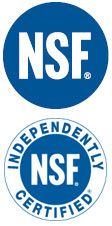Certified Products Have a “Leg Up” in the Marketplace
Finding quality products in a marketplace flooded with options can be challenging. How can you tell if a product is safe, reliable, durable and capable of meeting the claims made on its packaging and literature?

WQA’s Certified Product Listings are available to help connect consumers with water treatment products that have been tested and certified to industry standards. WQA’s Gold Seal Product Certification Program ensures that the product is constructed or formulated from safe materials, the claims listed on the packaging are backed by test data, and the product will hold up under normal usage conditions.
WQA maintains a complete listing of all products and components that have earned the Gold Seal and Sustainability Marks. Only products that pass the rigorous testing requirements of industry standards, pass annual manufacturing facility audits, and comply with WQA’s Certification Schemes can be found in this listing.
The NSF Mark
 The NSF mark is your assurance that the product has been tested by one of the most respected independent certification organizations in existence today. It is valued by consumers, manufacturers, retailers and regulatory agencies worldwide.
The NSF mark is your assurance that the product has been tested by one of the most respected independent certification organizations in existence today. It is valued by consumers, manufacturers, retailers and regulatory agencies worldwide.
The NSF certification mark on a product means that the product complies with all standard requirements. NSF conducts periodic unannounced inspections and product testing to verify that the product continues to comply with the standard.
The mark also provides:
- Knowledge that an impartial review against established criteria or guidelines has been conducted
- Evidence that product labeling and claims have been objectively reviewed by a trusted third party
- A way to differentiate your product from your competitors’ and gain advantage in the market
- Evidence of your organization’s company-wide commitment to quality, compliance and safety
- Backing by a team of professionals dedicated to public heal
NSF developed its first drinking water treatment standard in 1973. Today, we test to seven point-of-use/point-of-entry (POU/POE) drinking water treatment standards and have certified thousands of systems and components.
The NSF POU/POE standards address the wide array of drinking water treatment technologies on the market today, including adsorptive medias, ion exchange, reverse osmosis, ceramic filters, pleated filters, ultraviolet (UV), distillation, reduction-oxidation (redox), shower filters and more.
Each NSF standard sets thorough health requirements and performance criteria for specific types of products. Contaminant reduction claims can be certified under each standard and can vary according to each water treatment technology capability. Systems that utilize more than one treatment technology may be certified under multiple standards.
NSF/ANSI 42: Drinking Water Treatment Units – Aesthetic Effects
NSF/ANSI 42 establishes the minimum requirements for the certification of POU/POE filtration systems designed to reduce specific aesthetic or non-health-related contaminants (chlorine, taste, odor and particulates) that may be present in public or private drinking water.
The scope of NSF/ANSI 42 includes material safety, structural integrity and aesthetic, non-health-related contaminant reduction performance claims. The most common technology addressed by this standard is carbon filtration.
NSF/ANSI 53: Drinking Water Treatment Units – Health Effects
NSF/ANSI 53 establishes the minimum requirements for the certification of POU/POE filtration systems designed to reduce specific health-related contaminants, such as Cryptosporidium, Giardia, lead, volatile organic chemicals (VOCs) and MTBE (methyl tertiary-butyl ether), that may be present in public or private drinking water.
The scope of NSF/ANSI 53 includes material safety, structural integrity and health-related contaminant reduction performance claims. The most common technology addressed by this standard is carbon filtration.
Reverse Osmosis (RO)
NSF/ANSI 58: Reverse Osmosis Drinking Water Treatment Systems
NSF/ANSI 58 establishes the minimum requirements for the certification of point-of-use (POU) reverse osmosis systems designed to reduce contaminants that may be present in public or private drinking water.
The scope of NSF/ANSI 58 includes material safety, structural integrity, total dissolved solids (TDS) reduction and other optional contaminant reduction claims. The most common optional claims addressed by NSF/ANSI 58 include cyst reduction, hexavalent and trivalent chromium reduction, arsenic reduction, nitrate/nitrite reduction, and cadmium and lead reduction.
[section name=”searching-solution-it no-parallax light no-overlay” parallax=”https://www.dsbls.com/wp-content/uploads/2016/01/pure-water-cta.jpg” btop=”6px solid #f4cc28″ top=”100px” bottom=”100px”]
Request a FREE Water Test
We simplify your business life by providing award winning customer service and proactive management of your office water equipment.
[button link=”https://www.dsbls.com/water-coolers-new-jersey-new-york/pure-water-info-request-form/” type=”yellow”]Request Now »
